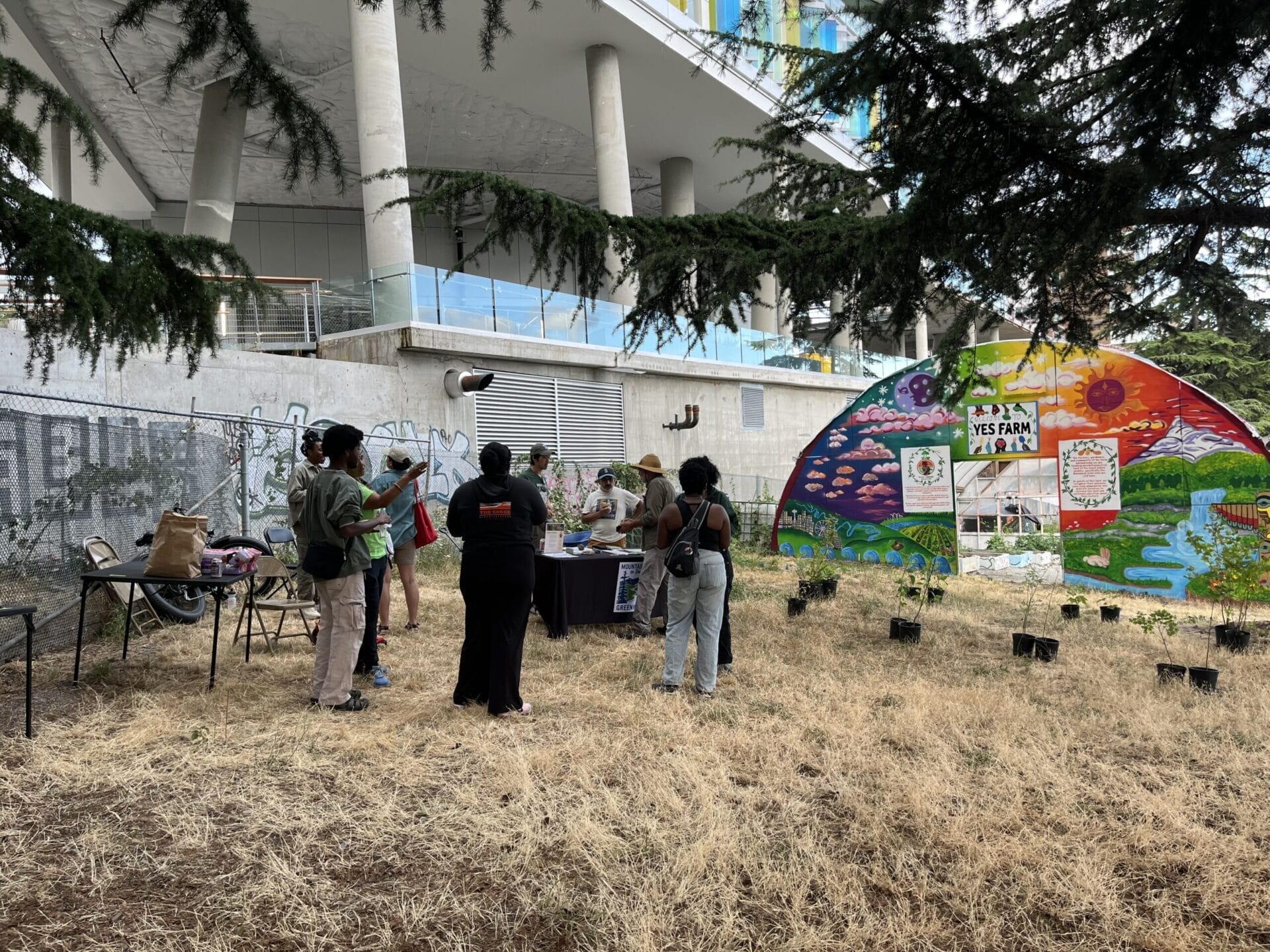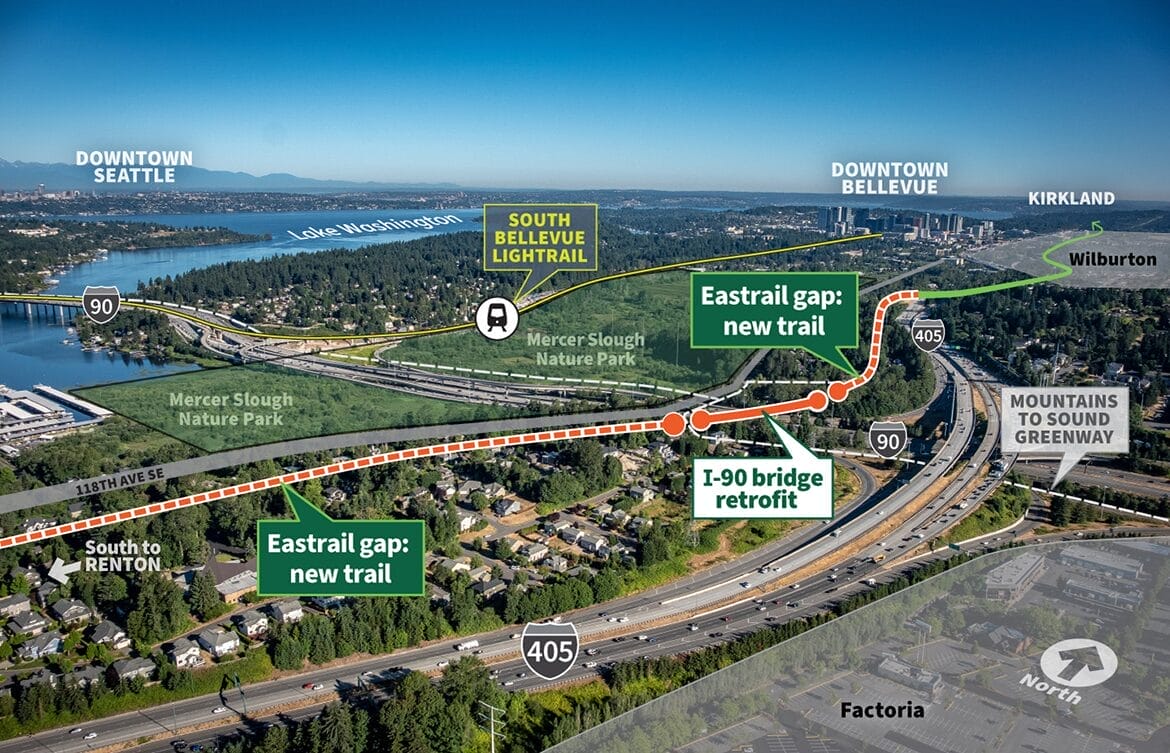2024 Accomplishments Across the Greenway
It’s hard to believe, but 2024 is already winding down and the new year will be here before we know it! With each year’s end, we like to pause and reflect on some of the accomplishments that have taken place across the Mountains to Sound Greenway National Heritage Area over the past 12 months. From new parks and trails, to important restoration work, educational initiatives, land acquisitions, and more — our partners have collectively accomplished so much to conserve and enhance this incredible landscape.
We’ll be celebrating many of these accomplishments at our Annual Dinner on November 14, and while it’s impossible to fully acknowledge every worthy person and accomplishment, we invite you to read on, and be amazed as we look back together at some great moments from 2024!
YES Farm and Forest
Thanks to the Seattle Housing Authority as well as the Washington State Department of Transportation for sharing a slice of freeway right-of-way along Interstate 5, Yes Farm has been operating for 7 years in downtown Seattle as the initial project of the Black Farmers Collective. Yes farm grows food to distribute directly to neighbors as well as through the Rainier Beach Action Coalition and Community Lunch on Capitol Hill. Yes Forest serves to connect the cultural greenspace of Yes Farm to the Chinatown/International District. It was dreamt of and designed as a collaborative project where a community-based organization could benefit from the resources and expertise of larger organizations, including EarthCorps and the Greenway Trust, as well as the City of Seattle and King Conservation District. It takes a village! Learn More

Community-Defined Salmon Recovery
The Community Defined Salmon Recovery Engagement project is a collaborative effort between ECOSS and the Mountains to Sound Greenway Trust aimed at empowering BIPOC communities in defining their own salmon recovery efforts and needs. Historically, salmon recovery initiatives have often been designed without adequate community input, leading to challenges in engagement and inclusivity. This project addresses these gaps by prioritizing engagement centered around Southeast Seattle and the area around the southwest portion of the Lake Washington/Cedar/Sammamish Watershed (WRIA 8). Over the past year, ECOSS has led the effort to build organizational capacity, initiate community engagement, and develop formal recommendations to enhance salmon recovery efforts.

Land Conservation Along Lake Washington
Washington State Parks now owns an additional 245 feet of lakeshore and 6.9 acres of forested habitat along Lake Washington, which extends St. Edward State Park to the north in Kenmore. Many thanks to conservation partners at Forterra for assistance in this acquisition, which will benefit urban forests and fisheries as it protects two streams that drain into Lake Washington.

Eastrail Connections
The newest link to the Eastrail was built this year on the NE 8th Bridge in Bellevue, creating connections between the Eastrail, East Link Light Rail, and the city. It includes interpretive art about the Japanese American Agricultural community that once shipped their goods from the site.
And in exceptionally rare, good news, two Eastrail projects received $30 million in federal grant funding this year. These funds will help close the gap over Interstate 90 and safely connect the Eastrail to the Mountains to Sound Greenway Trail in Bellevue, as well as plan the next segment of trail through Woodinville. This regional trail exists thanks to collaboration among multiple jurisdictions, non-profits, corporations, transit agencies, and utilities in King County working together to support corridor development, and we are so excited to see this decades-long collaboration continue.

Issaquah Land Conservation & Recreation
King County has conserved many important parcels of land that protect wildlife habitat, forests, and parks for public and ecological benefits this year. This year, we are celebrating King County Parks’ purchase of the final piece of the Raging River Quarry, a former gravel mine on the banks of this salmon-bearing river. Additionally, the county purchased 20 acres of wetland habitat along East Fork Issaquah Creek, another salmon-bearing stream, as well as a 50-acre forested addition to Cougar Mountain. Building on prior land acquisitions, the brand-new Big Tree Ridge Trailhead on the north flank of Cougar Mountain is now open, within walking distance of the Issaquah Transit Center. Funding for these projects came from Conservation Futures, the King County Parks Levy, and the Washington Wildlife and Recreation Program.


Waskowitz Outdoor Education Center Conservation
Nestled within the forested landscape near North Bend lies Waskowitz Outdoor Education Center. Each year, this former Civilian Conservation Corps camp hosts thousands of students for outdoor, experiential learning. South King County’s Highline School District had the foresight to purchase the camp in 1957, and all Highline students have the opportunity to come here. The trails and forests surrounding the camp buildings had an uncertain future until this year when the Trust for Public Land, Highline Public Schools, and King County teamed up to place a conservation easement on the 345 acres of enchanting woods surrounding Waskowitz. A classic win-win, the deal also provided $7.3 million for Highline to invest in an endowment fund for the education center. This forest along the Snoqualmie Valley Trail and the South Fork Snoqualmie River is now permanently protected for students and recreation-seekers to enjoy. Learn More

Denny Creek Trailhead
Thanks to the Great American Outdoors Act, the single largest investment in public lands in U.S. history, one of the most visited recreational complexes in the Interstate 90 corridor has been dramatically improved at Denny Creek! This project, completed this year, adds increased parking capacity including ADA parking, habitat restoration improvements around the parking areas, and a newly constructed loop road to alleviate traffic concerns. This winter, Denny Creek will become one of the newest Sno-Parks in the Washington State Parks’ system, and the new trailhead was designed to be easily plowed and eventually accessible by transit. Learn More

Middle Fork Snoqualmie River Access Improvements
Promoting safe and sustainable access to the Congressionally-designated “Wild and Scenic” Middle Fork of the Snoqualmie River has been a priority for the Greenway Trust and the Middle Fork Outdoor Recreation Coalition. Dahlgren Family Park and Tanner Landing, Mine Creek, Russian Butte View, and the Middle Fork Trailhead have all been improved to continue providing areas for people to walk, swim, fish, and picnic, and to protect sensitive natural areas along the river. Learn More

Washington Cascade Land and Water Conservation Fund Project Completion
After a decade of effort, local partners including The Nature Conservancy, US Forest Service, Yakama Nation, Yakima Basin Integrated Plan, Checkerboard Partnership Planning Committee and state and federal elected officials completed the Washington Cascades Land and Water Conservation Fund Project. With $46 million in federal Land and Water Conservation Fund dollars, project partners protected 30,000 acres of private checkerboard lands in the Upper Yakima Watershed. The lands are now in public ownership as part of the Okanogan Wenatchee National Forest, securing year-round recreation access, vital headwater habitat for fish and wildlife, and essential water supply for downstream communities.

Collaborative Conservation at Springwood Ranch
In partnership with the Yakima Basin Integrated Plan, the Trust for Public Land ventured into the world of ranch management when it acquired the 3600-acre Springwood Ranch property near Thorp in March of 2023. Since that time, TPL and the Integrated Plan have worked tirelessly to secure funding from the Washington State Legislature that allowed TPL to transfer permanent ownership of the land to four of the Yakima Basin Integrated Plan partners.
In a first-of-its-kind model, the Yakama Nation and Washington Department of Fish and Wildlife will co-own one parcel of the land for protection and restoration of ecological and cultural values. A second parcel will be solely owned by the Yakama Nation. On a third parcel, the Kittitas Reclamation District and the Yakima Basin Integrated Plan will explore feasibility for a new off-channel storage reservoir. Kittitas County will own and manage the remaining parcel for agriculture and other uses allowed by the County Comprehensive Plan.
The acquisition of Springwood Ranch was a result of tremendous partnership between TPL, the four new landowners, the Washington State Legislature, the Yakima Basin Integrated Plan, and many, many others. Learn More

Ambassador Programs Across The State
Trailhead and Wildlife Ambassadors were out and about this summer across the state! These programs teach recreators about environmental stewardship, outdoor ethics, and responsible recreation. This year, the Snoqualmie Tribe, Washington Department of Fish and Wildlife, Washington Trails Association, Conservation Northwest, and the Mountains to Sound Greenway Trust collectively engaged more than 17,000 visitors in programming across 20 locations all over the state. Learn More

1 Million Trees & Shrubs
This year marks a huge milestone for the Greenway…since our first tree planting at Jose Rizal Park in Seattle in 1993, the Greenway Trust’s volunteers, students, and partners in habitat restoration have planted more than one million trees and shrubs across the Greenway National Heritage Area! These plantings are supporting salmon habitat, urban forest canopies, communities, and strong native ecosystems in western and central Washington for generations to come. Some of these trees are now more than 30 years old!

Want to stay in the loop about everything happening across the Greenway NHA? Make sure you’re on our e-newsletter list!





